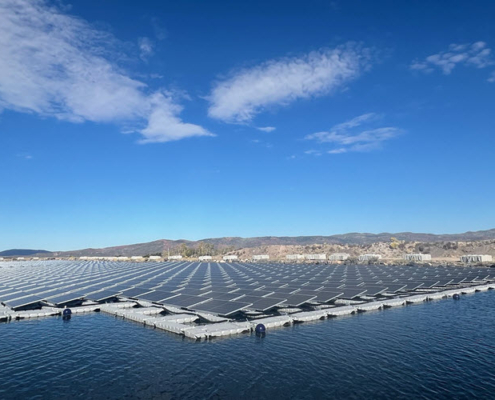December 2, 2025
Share this post
Innovative PV systems are riding the wave of renewable energy expansion
Floating solar, or floating photovoltaic (FPV) technology, has emerged as a creative approach in the clean energy sector. By installing PV systems on bodies of water, developers can beneficially repurpose valuable – albeit liquid – acres of property, avoid competition with agriculture or commercial development, and introduce a sustainable technology where previously only traditional land-based solutions existed.
Strategic Applications: Where Floating Solar Delivers Value
The applicability of floating solar is expanding, with core adoption in regions where land constraints, underutilized bodies of water, or existing infrastructure favor a water-based approach. From hydroelectric reservoirs and industrial retention ponds to water treatment facilities and commercial cooling basins, FPV systems’ adaptability extends from large-scale public utilities and energy-hungry data centers and smaller, decentralized projects.
For many regions and applications, bodies of water represent an underutilized asset. Key drivers include declining water levels due to drought or evaporation, energy intensity at water-related facilities, and community resistance to land-intensive solar. Floating solar systems can be integrated at sites where infrastructure and permitting already exist, often reducing roadblocks of deployment.
The Proven Benefits of Going Afloat
Floating solar arrays offer more than just land conservation, they deliver measurable performance and environmental advantages:
- Higher Energy Yield: Panels benefit from the natural cooling effect of water, boosting efficiency compared to ground-mounted systems, especially in hot climates.
- Water Conservation: Covering water surfaces can reduce evaporation, helping preserve billions of gallons over a system’s lifespan, critical for utilities and agriculture in arid regions.
- Improved Water Quality: Shading limits sunlight penetration, which helps reduce algal blooms and lowers the need for chlorine treatment.
- Lower Operating Costs: O&M expenses are typically lower due to the absence of landscaping and wildlife management required for land-based arrays.
- Enhanced Performance with Bifacial Panels: Water’s high reflectivity (albedo) increases the energy output of bifacial PV modules.
Inside the Technology: Engineering for Water
A floating solar array draws on familiar components, such as solar panels, inverters, transformers, and wiring, but adapts them for aquatic service. Most floating systems use modular, high-density polyethylene platforms that are both UV stabilized and resistant to corrosion. These floats interlock like a raft, distributing loads, and permitting movement with water levels while stabilizing through carefully-engineered anchors.
Electrical designs are tailored for safety and durability. Underwater and shore cabling employs robust insulation and secure channels, often running along floating gangways that rise and fall with the water, ensuring OSHA-compliant maintenance access. Inverters and transformers may be mounted on shore or on dedicated floats, depending on site specifics, operational needs, and regulatory requirements. While combining water with electricity provokes understandable caution, decades of experience with subsea cables and storm-hardened solar infrastructure translate seamlessly to floating solar; the technologies employed are already proven in even more challenging marine applications.
Getting the installation right means accounting for anchoring method, buoyancy, wave action, and water level fluctuations. For high-variation reservoirs or floodplains, flexible anchoring keeps arrays stable without risking damage during extreme events. The potential for freezing or high-energy wave conditions must also be evaluated; best practices dictate avoiding problematic waters.
Solutions Tailored to Individual Environments
No two solar projects are alike, and the success of each depends on an “all of the above” mindset, combining floating, rooftop, and ground-mount solar based on what site conditions and stakeholder input might dictate. Ameresco has experience with installations of floating solar technology, tailored to the unique site-specific application.
- U.S. Army Fort Bragg, NC: A floating solar microgrid at Fort Bragg represents the U.S. Army’s first operational project of its kind. Faced with a need to modernize critical infrastructure and increase energy resilience while preserving military land for essential operations, a 1.1 MW FPV system was deployed atop Big Muddy Lake. The result: enhanced grid independence, reduced land use, and improved efficiency due to water cooling. Integration with a large battery energy storage system underscores the array’s strategic value, providing backup power to a mission-critical site in a way that conventional solar could not achieve so flexibly.
- Mountain Regional Water Special Service District – Signal Hill Water Treatment Plant, UT: The Signal Hill floating solar array sits on the retention pond at a water treatment plant in Park City. Engineers faced the challenge of a lined reservoir, which precluded ground-mount anchoring. The solution came in the form of a concrete ballast system positioned onshore, securing over a thousand PV panels that now offset 90% of facility energy consumption. Beyond delivering significant operational savings, the project successfully minimizes evaporation, protects water quality, and offers a replicable model for utilities seeking rapid progress toward net zero goals, even in constrained or protected spaces.
The Horizon: Floating Solar’s Place in America’s Energy Transition
Floating solar stands out as an engineering feat, and as a vital and pragmatic solution uniquely equipped to address today’s intertwined challenges of land scarcity, water conservation, and rising energy demand. For communities and organizations alike, it represents a strategic pathway to maximize the utility of both land and water resources.
With grid constraints apparent, rising tides will float all ships as we get creative to build energy generation infrastructure. Floating solar represents a leap forward in efficient, sustainable energy. Floatovoltaics are poised to scale as a creative solution in applicable environments with demonstrable cost, yield, and ancillary benefits. Ultimately, floating solar’s impact goes well beyond technology – it empowers organizations to lead in resilience, efficiency, and stewardship as the energy landscape continues to evolve.
Watch this free on-demand webinar where Ameresco joined industry partners to discuss “The Untapped Potential of Floating Solar.” In this session, panelists highlight real-world applications of this emerging technology and example projects.


